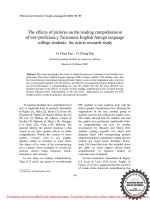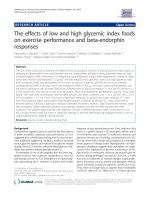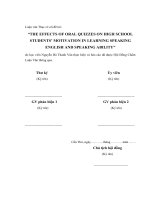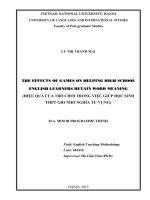The effects of liveworksheets on high school students english grammar learning
Bạn đang xem bản rút gọn của tài liệu. Xem và tải ngay bản đầy đủ của tài liệu tại đây (984.78 KB, 99 trang )
MINISTRY OF EDUCATION AND TRAINING
QUY NHON UNIVERSITY
TRAN THI LAP
THE EFFECTS OF LIVEWORKSHEETS
ON HIGH SCHOOL STUDENTS’ ENGLISH
GRAMMAR LEARNING
Field: Theory and Methodology of English Language Teaching
Code: 8140111
Supervisor: Le Nhan Thanh, PhD
Binh Dinh - 2023
BỘ GIÁO DỤC VÀ ĐÀO TẠO
TRƯỜNG ĐẠI HỌC QUY NHƠN
TRẦN THỊ LẬP
ẢNH HƯỞNG CỦA VIỆC SỬ DỤNG WEBSITE
LIVEWORKSHEETS ĐẾN VIỆC HỌC NGỮ PHÁP
TIẾNG ANH CỦA HỌC SINH THPT
Ngành: Lý luận và phương pháp dạy học bộ môn Tiếng Anh
Mã số: 8140111
Người hướng dẫn: TS. Lê Nhân Thành
Bình Định - 2023
i
STATEMENT OF AUTHORSHIP
Title: “The effects of Liveworksheets on High school students’ English
grammar learning”
I hereby certify that the thesis is entirely my own original work except where
otherwise indicated. I further declare that this work is submitted in partial
fulfilment for the M.A. thesis in English and has not been submitted elsewhere in
any other form for the fulfilment of any other degree or qualification.
Binh Dinh, 2023
Tran Thi Lap
ii
ACKNOWLEDGEMENTS
Without the assistance of many people, this thesis could not have been
completed. I would like to express my profound gratitude and respect to those
who provided me with advice and assistance when I conducted this research.
First and foremost, I would like to express my deepest gratitude to my
supervisor, Dr. Le Nhan Thanh, for his enthusiastic and continuous support,
encouragement, and valuable advice on my thesis writing. Without his
recommendations and constructive comments, I would never have been able
to complete my thesis.
My sincere gratitude also extends to all the lecturers in the Department
of Foreign Languages and the Department of Pedagogy at Quy Nhon
University for their precious knowledge and guidance during my two years of
study.
I would like to thank the school administrators and my colleagues at
Quang Trung High School for their enthusiastic support.
I would like to offer my special thanks to those who devoted their time
to participating in this research. If it had not been for their willingness and
enthusiasm, I could not have collected the data for my study.
Last but not least, I owe a great debt of gratitude to my beloved family,
whose support and encouragement have always been a great source of
motivation that helped me overcome all obstacles and complete my thesis.
iii
ABSTRACT
With the advancement of technology, the integration of technology in
education has gradually become inevitable. This research aims to investigate
the effects of Liveworksheets on students’ grammar learning at a high school
in Binh Dinh province. The study focused on students’ learning outcomes,
which could be observed through the significant differences in grammar
achievement scores between the control and experimental groups.
Additionally, the students’ attitudes towards learning grammar with
Liveworksheets in class were investigated. Results from the questionnaire
reflected that students in the experimental group demonstrated positive results
regarding all three attitudinal components, including cognition, affect, and
behavior, claiming that Liveworksheets activities helped teach grammar
lessons more effectively. Findings from the tests revealed that students had
experienced an improvement in their grammar memorization over the eight
weeks of study, and the primary reason for this improvement was attributed to
the use of Liveworksheets in the grammar learning classroom. Based on the
findings of the study, implications for both students and teachers, limitations
of the study, and recommendations for future research on language learning
through educational platforms are suggested.
Keywords: Liveworksheets, educational platform, learning outcomes,
grammar, high school students.
iv
TABLE OF CONTENTS
STATEMENT OF AUTHORSHIP ................................................................... i
ACKNOWLEDGEMENTS .............................................................................. ii
ABSTRACT ..................................................................................................... iii
TABLE OF CONTENTS ................................................................................. iv
LIST OF ABBREVIATIONS ......................................................................... vii
LIST OF TABLES ......................................................................................... viii
LIST OF FIGURES, CHARTS........................................................................ ix
CHAPTER 1. INTRODUCTION .................................................................. 1
1.1. Rationale..................................................................................................... 1
1.2. Aim and Objectives of the Study ............................................................... 2
1.3. Research Questions .................................................................................... 3
1.4. Scope of the Study ..................................................................................... 3
1.5. Significance of the Study ........................................................................... 3
1.6. Organization of the Study........................................................................... 4
CHAPTER 2. LITERATURE REVIEW ...................................................... 5
2.1. English Grammar Teaching and Learning ................................................. 5
2.1.1. Definition of Grammar..................................................................... 5
2.1.2. English Grammar Teaching and Learning ....................................... 6
2.1.3. Ways to Teach English Grammar ................................................. 8
2.1.4. Stages of Teaching Grammar ........................................................... 9
2.1.5. Learning Outcomes ........................................................................ 10
2.2. Attitudes ................................................................................................... 12
2.2.1. Definition........................................................................................ 12
2.2.2. Attitude Components...................................................................... 12
v
2.2.3. The Roles of Students’ Attitudes in Grammar Learning ............... 13
2.3. Educational Technology in Language Teaching and Learning ............... 14
2.3.1. Technology and Education............................................................. 15
2.3.2. Technology Application in Grammar Teaching and Learning ...... 15
2.4. Using Liveworksheets in Grammar Teaching and Learning ................... 16
2.4.1. What is a Worksheet? ..................................................................... 16
2.4.2. Overview of Liveworksheets ......................................................... 17
2.5. Literature on Liveworksheets and Language Learning. .......................... 19
2.6. Conceptual Framework for the Present Study ......................................... 26
CHAPTER 3. METHODOLOGY ............................................................... 27
3.1. Research Design ....................................................................................... 27
3.2. Research Site ............................................................................................ 28
3.3. Participants ............................................................................................... 29
3.4. Materials................................................................................................... 30
3.5. Data Collection......................................................................................... 30
3.5.1. Teaching the Experimental Group ................................................. 32
3.5.2. Research Instruments ..................................................................... 33
3.5.2.1. The Grammar Achievement Tests. ........................................... 33
3.5.2.2. The Questionnaire..................................................................... 37
3.6. Data Analysis ........................................................................................... 40
3.6.1. The Achievement Test Data ........................................................... 40
3.6.2. The Questionnaire Data.................................................................. 41
CHAPTER 4. FINDINGS AND DISCUSSION ......................................... 42
4.1. The Effectiveness of Liveworksheets on Students’ Grammar Achievement .. 42
4.1.1. Pre-test Results ............................................................................... 42
4.1.2. Post-test Results ............................................................................. 44
4.1.3. Paired Sample T-test Results ......................................................... 46
vi
4.2. Students’ Attitudes Towards Learning Grammar with Liveworksheets
in the Classroom ........................................................................... 47
4.2.1. Students’ Background .................................................................... 50
4.2.2. Students’ Attitudes Towards Liveworksheets in Grammar Lessons
.................................................................................................................. 50
4.2.2.1. Cognitive Components. ............................................................ 50
4.2.2.2. Affective Components. ............................................................. 53
4.2.2.3. Behavioral Components. .......................................................... 55
4.2.2.4. Students’ Opinions on the Use of Liveworksheets. ................. 57
4.3. Summary .................................................................................................. 60
CHAPTER 5. CONCLUSION ..................................................................... 62
5.1. Summary of Key Findings of the Study .................................................. 62
5.2. Conclusion................................................................................................ 65
5.3. Implications .............................................................................................. 66
5.3.1. Implications for School Administrators ......................................... 66
5.3.2. Implications for EFL Teachers....................................................... 67
5.3.3. Implications for Students ............................................................... 68
5.4. Limitations ............................................................................................... 68
5.5. Recommendations for Further Studies..................................................... 69
REFERENCES .............................................................................................. 71
APPENDICES ............................................................................................... 79
APPENDIX 1: PHIẾU KHẢO SÁT ............................................................... 79
APPENDIX 2: QUESTIONNAIRE................................................................ 82
APPENDIX 3: GENERAL ENGLISH TEST (PRE-TEST) .......................... 85
APPENDIX 4: PROGRESS TEST (POST-TEST)......................................... 87
vii
LIST OF ABBREVIATIONS
CALL: Computer-Assisted Language Learning
CEFR: The Common European Framework of Reference for Languages
EFL: English as Foreign Language
E-LKPD: Development of Electronic Student Worksheets
ICT: Information and Communications Technology
MALL: Mobile-Assisted Language Learning
viii
LIST OF TABLES
Table 2.1: Jabbar & Felicia (2015)’s Learning Outcomes Description .......... 11
Table 2.2: Summary of Previous Studies........................................................ 24
Table 3.1: Participants of the Study ................................................................ 29
Table 3.2: Review of the Grammatical Points in Units .................................. 30
Table 3.3: General English Test (Pre-test)...................................................... 36
Table 3.4: General English Test (Post-test) .................................................... 36
Table 3.5: Desciption of the Questionnaire on Students’ Attitudes Towards
the Use of Liveworksheets............................................................ 40
Table 3.6: Total Score Interpretation .............................................................. 41
Table 4.1: Pre-test Scores of the Control and Experimental Groups.............. 42
Table 4.2: Post-test Scores of the Control and Experimental Groups ............ 44
Table 4.3: Statistical Results From the Pre-test and Post-test of the Control
and Experimental Groups ............................................................. 46
Table 4.4: Students’ Beliefs and Thoughts About Liveworksheets
Activities ....................................................................................... 51
Table 4.5: Students’ Feelings About the Use of Liveworksheets in
Grammar Lessons ......................................................................... 53
Table 4.6: Students’ Behaviors in the Grammar Lessons With the Use of
Liveworksheets ............................................................................. 55
Table 4.7: Reasons Behind Students’ Preferences for Using
Liveworksheets in Grammar Learning ......................................... 57
Table 4.8: Reasons Behind Students’ Disfavor for the Use Liveworksheets
in Grammar Learning.................................................................... 59
ix
LIST OF FIGURES, CHARTS
Figure 4.1: The Results of the Reliability of Questionaire Items No. 4-6 ..…48
Figure 4.2: The Results of the Reliability of Questionaire Items No. 7-9…...49
Figure 4.3: The Results of the Reliability of Questionaire Items No. 10-12...49
Chart 4.1: Results of the Pre-test of the Control and Experimental Groups... 43
Chart 4.2: Results of the Post-test of the Control and Experimental Groups . 45
Chart 4.3: Students’ Opinion on Future Use of Liveworksheets in
Classroom ..................................................................................... 60
1
CHAPTER 1. INTRODUCTION
Chapter 1 introduces the rationale underlying this current study. The
chapter includes 6 main parts: the rationale, the aim and objectives of the
study, the research questions, the scope of the study, the significance of the
study, and the organization of the study.
1.1. Rationale
Grammar plays an important role in the language curriculum because it
provides a foundation for understanding and applying a language. Grammar
acquisition is paramount in the teaching and learning of any language. It is
also one of the more difficult aspects of language teaching. Teachers teach
grammar by explaining the forms and rules and then drilling students with
reproductive exercises. This results in bored, disaffected students who can
produce correct forms in exercises and tests, but consistently make errors
when they try to use the language in a natural context (Byrd, 1998).
According to Leo (2021), he also provides a general view that language
teaching is one of the most challenging things, especially English and its
grammar rules. Most students think it is boring, or they are not at all
interested in learning grammar or English in general. Therefore, it is crucial
for teachers to adopt suitable methods to appeal to students’ interests and
teach them effectively.
On the other hand, with technological advances, the integration of
technology in education has gradually become inevitable. Several
applications and technology platforms can be utilized as learning media to
support the effectiveness of learning. One of the web-based educational
platforms newly used is Liveworksheets ( />Through this application, students can participate in interactive classroom
2
activities using their mobile devices to enhance their learning experience. It is
such a positive thing because learning does not always use books and paper as
the media.
In addition, in Circular 32/2020 of the Ministry of Education and
Training on Lower secondary school, upper secondary school, and multi-level
school charter, students are now allowed to use their mobile phones for
learning purposes in the classroom when they get teachers’ permission. In this
view, the use of technology is encouraged in the classroom, especially the use
of mobile phones in teaching and learning.
Thanks to the improvement of technology, educational applications are
now widely used at all levels of education. The problem is that few studies
have been conducted on the use of online applications for language teaching
and learning in high schools in Vietnam. Consequently, to fill the research
gap concerning the role of online applications in improving English learners’
grammar knowledge in Vietnamese high schools, this study aims to
investigate whether Liveworksheets has any significant effects on the
grammar learning of EFL high school students. This study is expected to
contribute to other researchers and teachers by encouraging them to use
Liveworksheets as an online tool for their classes to help students improve
their English grammar knowledge.
1.2. Aim and Objectives of the Study
This paper aims to measure the impact of using the Liveworksheets
website as an online tool to enhance high school students’ proficiency in
English grammar through interactive exercises.
The specific objectives are set as follows:
- To investigate high school students’ attitude towards Liveworksheets in their
3
English grammar learning, and
- To examine the effect of Liveworksheets on high school students’ English
grammar learning.
1.3. Research Questions
In an attempt to achieve the above-presented aim and objectives, the
study seeks to answer the following research questions:
1. To what extent does the use of Liveworksheets affect their English
grammar learning?
2. What are high school students’ attitude towards Liveworksheets in learning
English grammar?
1.4. Scope of the Study
The study is carried out with the participation of 85 students who have
been learning English at a high school located in the Southwestern part of
Binh Dinh Province. It concentrates on investigating how using
Liveworksheets improves students’ grammar learning. Moreover, this study
focuses on students’ attitude toward using Liveworksheets in grammar
teaching and learning. The course book that the researcher used in this action
research was English TextBook 10, Global Success, published by Vietnam
Education Publishing House.
1.5. Significance of the Study
Liveworksheets is a new online website, so there has been little
research conducted on the use of Liveworksheets, especially in the context of
EFL high schools. It is significant to carry out the study because the findings
will provide valuable information that can significantly contribute to raising
awareness among teachers and students of using Liveworksheets in EFL high
school contexts. The study is expected to shed light on how Liveworksheets
can positively affect students’ learning. The results of the study are expected
4
to provide implications for teachers who are interested in using
Liveworksheets in their classes, as well as for students who want to learn
grammar effectively and interestingly.
1.6. Organization of the Study
The thesis consists of five chapters:
Chapter 1, Introduction, presents the rationale, which introduces the
reasons why the researcher chose to conduct the study, the aim and
objectives, the research questions, the scope, the significance, and the
organization of the study.
Chapter 2, Literature Review, explores some previous relevant studies and
the relevant theoretical background for the study.
Chapter 3, Methodology, explains the research methods and introduces
the research instruments used to collect data for the study and the materials
used for the intervention in detail. This chapter will come to an end with the
procedure to conduct the study and the methods of data analysis.
Chapter 4, Findings, reports the results of the study, and some
explanations, and comments on these findings.
Chapter 5, Discussion and Conclusion, makes a conclusion to the report
of the study. First, it will interpret the findings and discuss interference with
the previous studies. Then, it provides the pedagogical implications and some
limitations of the study. Finally, the suggestions for further research will be
the last part of this chapter.
5
CHAPTER 2. LITERATURE REVIEW
The purpose of this study is to examine the effects of using
Liveworksheets on High school students’ English grammar learning. It
reviews the literature knowledge related to (1) English grammar teaching
and learning; (2) Attitude; (3) Educational technology in language teaching
and learning; (4) Using Liveworksheets in grammar teaching and learning;
(5) Literature on Liveworksheets and language learning; (6) Conceptual
framework for the present study.
2.1. English Grammar Teaching and Learning
2.1.1. Definition of Grammar
Every language has its own rules for combining words to form sentences
that convey the meaning of the speakers or writers correctly. English is not an
exception. As Thornbury (2002) puts it:
“Grammar is partly the study of what forms or structures are
possible in a language. Thus, grammar is a description of the rules
that govern how a language’s sentences are formed.” (p. 1)
Grammar is also defined as “the way words are put together to make
correct sentences” (Ur, 1996). Additionally, grammar is also an important set
of rules that should be followed to compose language for expressing oneself.
Brown (2007) holds the view that grammar is the system of rules
governing the conventional arrangement and relationship of words in a
sentence. Especially, Crystal (2004) stated that a better understanding of how
grammar works would result in better monitoring of the meaning and a more
effective way of using language. In line with the research, Larsen-Freeman
(1995) mentioned a three-dimensional grammar framework, including form/
6
structure, meaning/semantics, and use/pragmatics. With the form/structures,
students should be able to use grammar correctly in terms of structures and
rules of grammatical points, while the meaning/semantics focuses on lexical
meaning.The use/pragmatics involves social context, deciding when and why
that grammar point is used in the specific context.
According to the Oxford Dictionary, grammar is (1) the rules in a
language for changing the form of words and combining them into
sentences; (2) a person's knowledge and use of a language; and (3) a book
containing a description of the rules of grammar for a particular language
(Hornby, 1995, p. 517). Besides, Richards et al. (1992) also gave another
definition of grammar in the Dictionary of Language Teaching and Applied
Linguistics. They define grammar as “a description of the structure of a
language and the way in which linguistic units such as words and phrases
are combined to produce sentences in the language” (p. 161).
To high school students, English grammar is closely associated with
elements of structure and rules, as it is emphasized in exercises and exams.
This has led to a narrow view of grammar in language learning and teaching.
In this study, English grammar is simply understood as a system of
structures that shows how words and phrases are combined and t h e rules
that speakers of English follow to make sentences meaningful.
2.1.2. English Grammar Teaching and Learning
Grammar teaching is an important part of language teaching in high
schools. DeKeyser (1995) believed that grammar teaching is essential for
language learning because it provides learners with the basic building blocks
of language. He also pointed out that awareness of target structures and forms
is essential for second language learning.
7
According to Fromkin, Rodman, and Hyams (2017), grammar
instruction can help learners acquire and use language because it guides how
language is produced. They also suggest that form-focused language
instruction is necessary for learners to achieve accuracy in the target
language.
Another significant point made by Zhang (2009) is that grammar
instruction is fundamental in second language teaching because grammar is
the foundation of the English language. Without grammar, learners find it
impossible to learn a language. The most important goal of language learning
is to help learners communicate effectively and appropriately in social
situations. Thus, grammar teaching can help achieve this goal by empowering
students to know how to combine vocabulary to make a meaningful sentence
that can be used for their communicative purposes. Besides, he argues that
grammar learning is not a natural process and requires explicit teaching by
teachers who can help learners learn grammar more effectively and
accurately. Learners can learn other skills such as listening, speaking, reading,
and writing on their own, but they need support from teachers to learn
grammar. Based on the discussion so far, it is obvious to summarize that
grammar teaching is an integral part of language teaching. This is because
grammar is considered a core part of a language and has a decisive effect on
second language learning success.
According to Agis (2021), English grammar is fundamental to language
learning and the basis of several language skills. This project focuses on
grammar studies because it emphasizes the importance of this skill, which is
often neglected by most teachers. Some teachers do not know how to teach
grammar effectively, and students often find it boring and difficult to
understand. This is why some students are unable to follow grammatical
structures and often fail tests and assignments.
8
In a similar vein, Huang (2005) argues that teaching English grammar as a
foreign language class can make a significant contribution to students’ linguistic
proficiency. This is because learners who do not know grammar or who have
limited knowledge of grammar are likely to be confused by complicated
expressions. Despite being one of the most important factors in developing
learners’ language outcomes, a number of students do not know how to use
grammar effectively, especially when expressing their own thoughts or feelings.
As a result, grammatical understanding will ultimately affect students’ ability to
communicate effectively. Besides, Crystal (2004) states that,
“Grammar is the structural foundation of our ability to express
ourselves. The more we are aware of how it works, the more we can
monitor the meaning and effectiveness of the way we and others use
language. It can help foster precision, detect ambiguity, and exploit the
richness of expression available in English. Additionally, it can help
everyone, not only teachers of English, but teachers of anything for all
teaching grammar is ultimately a matter of getting to grips with
meaning”. (p. 223)
Based on the definition above, it can be concluded that grammar has
always been the elements of a language and the rules for how to combine
these elements to create meaningful sentences. In other words, grammar
teaching helps learners quickly identify and understand language patterns and
structures so that they can use them in their speaking, reading, listening, and
writing. In addition, it improves learners’ accuracy and their ability to acquire
language.
2.1.3. Ways to Teach English Grammar
English grammar can be taught deductively (Woolfork, 2001) or
inductively (Lohman, 2002) to high school students. In the inductive method,
grammar rules can be illustrated by examples, or teachers can tell a story or
9
give a situation so that students make sentences and draw the structure by
themselves. In the deductive method, the grammar structures are presented to
the students before they practice them. However, the inductive method may
be more useful in high schools because it requires students to focus on the
learning process. In simple words, a deductive way is a technique that works
from general to specific while an inductive way is a technique that works
from specific to general.
Bastone (1994, p. 4) commented that grammar taught purely through
controlled exercises may not be retained by learners for long. He emphasized
that teachers should provide activities that require students to actively
manipulate language by thinking about and applying the grammatical rules
and principles focused on the lesson.
In most high schools, teachers typically employ the deductive method to
teach grammar. They begin by introducing a grammar rule and then provide
examples illustrating how the rule is applied. However, this approach has
faced criticism for being both tiring and boring. In these classes, teachers
often dominate the lessons, while students listen passively and take notes.
Their passivity can give the impression of a lack of motivation, making it
challenging for them to learn. The absence of active engagement may result
in lessons that are teacher-centered and lack creativity and challenge.
2.1.4. Stages of Teaching Grammar
There are three stages of teaching English grammar: pre-teaching, while-
teaching, and post-teaching.
In the first stage, teachers often use some activities to get students ready
to learn. They can, for example, give pictures, situations, exercises, or games
to think about. This can help students to “rack their brains” when learning
English grammar in class.









